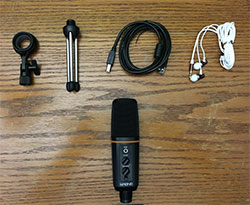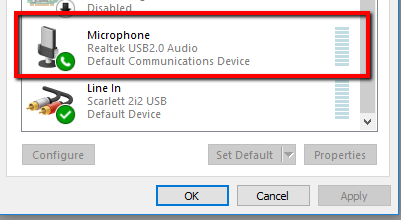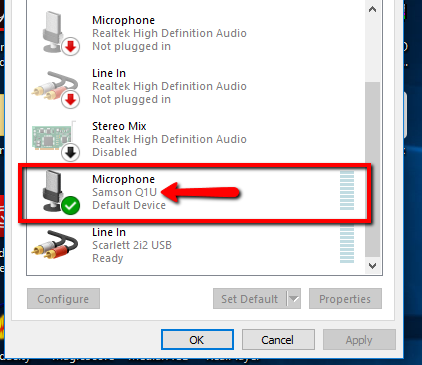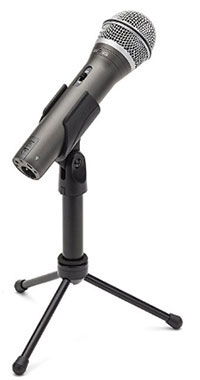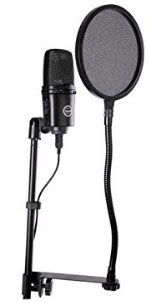The MicPort Pro 2 is the ultimate solution for recording professional quality audio on the road. It’s a portable professional recording studio allowing you to record with your best mics and just the MicPort and a mobile device. Highly recommended if you need a portable recording solution.
My Star Rating –
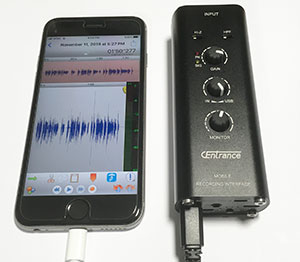
I just got the chance to review the CEntrance MicPort Pro 2 portable audio interface. The phrase “big things come in small packages” could have been invented for this little device. There is a LOT packed into a small package here.
The original MicPort Pro came out about 10 years ago and was revolutionary then, because it offered broadcast quality audio, but was so small you could put it in your pocket. With the MicPort Pro 2, CEntrance have added a number of amazing features.
So What Can The MicPort Pro 2 Do?
First of all, it is a top-notch audio interface that rivals the best “standard” interface units, which are usually boxes five times bigger than the MicPort Pro 2. So even though its main purpose is to serve as a portable recording solution, it could easily serve as your primary interface as well.
As you’ll hear in the audio samples in this review, the mic preamplifiers in the MicPort Pro 2 (hi-end Jasmine™ mic preamps) are super quiet. So you can make professional grade, low-noise recordings with it – not only on your computer, but also with a mobile device (phones and tablets) as well!
Here are the other awesome things it can do:
Other Nifty Features
Rechargeable
Unlike the original MicPort, this new version is rechargeable. So you don’t need a USB port from a computer to power it while using it. Just make sure you plug it in (to any USB source, including a portable power bank) to get it started charging as soon as you get it. Because it takes a few hours to charge it all the way up.
Also, it can take longer to charge if you plug it into a computer’s USB port. So be sure to charge it like you charge you mobile devices. CEntrance sells a Fast USB charger to get you up and running sooner if you need speed. Check that out here: https://centrance.com/store/Fast-USB-Charger-p112263503
A VERY cool thing about the MicPort Pro 2 being rechargeable is that since it does not rely on a computer USB for power, once it is charged, you can literally stick it into your pocket and be ready to record from anywhere. No computer needed.
Phantom Power
The MicPort provides true +48V phantom power. So you can use it with any high-end microphone, including, of course, studio condenser mics. There is a switch on the end of the device to turn phantom power on and off.
By the way, all the switches we’ll be talking about can be turned on/off with the handy tool that comes taped to the lid of the box. But if you lose that, you can easily move the toggles with a paper clip or even the end of a ball point pen.
Low Cut Switch
There is a low cut switch (high-pass filter) that you can use if you are in a noisy environment, especially outside where it might be windy. By turning this switch on, you can reduce low frequency noises like wind, or voice p-pops, etc. It will stop the noise right at the input jack before the preamp has a chance to overload and go into the red.
Neutrik™ combo input jack
The input jack accepts standard mic XLR (3-pin) plugs, or course. But you can also use quarter-inch plugs to connect bass or electric guitars! There is a DI (“direct inject” for use with electric guitar and recording) built right in. Just turn on the “Hi-Z” switch (which means High impedance, which is needed for electric guitars) if you want to record guitar and you’re all set.
Tripod Attachment
On the bottom of the unit is a standard tripod attachment – female 1/4-20. This is SUPER handy for portability. I have a mini tripod that stands on my desk. And I attached a large diaphragm condenser directly (as in no cable!) to the MicPort and was able to record that way.
Headphone Output
There is a 1/8″ (3.5mm) headphone jack on the unit that allows you to monitor what you are recording. The Blend Control knob “adjusts the mix between zero latency input signal and USB playback.” So if you have that knob turned all the way counter clockwise, you’ll ONLY hear the input – what’s coming through the mic. If you turn the knob all the way clockwise, you’ll ONLY hear what is playing back. You can dial in a mix of both signals by rotating the knob anywhere in between the two extremes. This is, of course, necessary if you are overdubbing to something already recorded or recording to a metronome in the app, etc.
Live Streaming
Since you can connect a high-quality studio mic with the MicPort to a mobile device, you can finally make your live streams sound super professional.
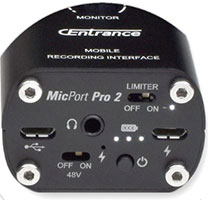
The Basic and Plus Versions of MicPort Pro 2
The Basic MicPort ($249.99) has all of the features I listed above, as well as mobile recording, of course. But there are two other features available on the Pro version – the “MicPort Pro 2 with Limiter ($279.99).
Limiter
As the name suggests, the Pro version has a switch that turns on a soft-knee limiter. This is an incredible help when recording in the field. You can’t always control levels as well as you’d like, and the limiter prevents any unexpectedly loud audio from clipping, which could ruin your recording. The “soft-knee” character of the limiter means you probably won’t even know it’s there. It just works to keep your audio from distorting from audio that would otherwise be too loud.
Dual Clipping Protection
The other additional feature you get with the Pro version is pretty darned cool – dual clipping protection. Basically this means that you get 2 ways of preventing clipping/distortion. One is the limiter, which we already discussed.
The other is a “safety track” that records at -12dB lower than the main recording! So even if you somehow manage to overload EVEN with the limiter turned on, your audio would not be ruined because you have the second safety recording available.
If you want to take advantage of the safety track, record in stereo. You’ll notice that one of the channels is 12dB lower in level. That is your safety track.
Mobile Recording
This is probably the most important feature of the new MicPort Pro 2, which you could NOT do with the original MicPort. As I mentioned earlier, you can use the MicPort Pro 2 with your mobile devices.
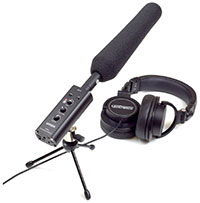
Why is this such a big deal? Well, it has been super difficult for companies to come up with good ways to allow you to use your “good” studio microphones – like large diaphragm condenser mics – with mobile devices. But CEntrance has figured out a great way to do it. Since the MicPort is rechargeable and has true +48V phantom power, you can simply plug a mic straight into the unit, turn on phantom power, and you’re ready to record into your phone or tablet.
For iOS devices, you will need a cable adapter to do mobile recording though. CEntrance recommended the Lightning to USB 3 Camera Adapter for recording with iPhones and iPads. And you will have to buy this separately (goes for about $39).
Mobile Apps For Recording
According the CEntrance website, compatible apps that work with both the MicPort Pro 2 and the Mixerface include:
- Audio Evolution (iOS/Android)
- Auria Pro (iOS)
- BandLab (iOS/Android)
- BeatMaker 3 (iOS)
- Cubasis (iOS)
- Field Recorder (Android)
- FL Studio Mobile (iOS)
- Garage Band (iOS)
- Luci Live (iOS/Android)
- N-Track (iOS/Android)
- Tieline Report-IT (iOS/Android)
- Twisted Wave (iOS)
While it does show that Garage Band (iOS) can be used, I don’t think that is a great choice if you’re doing vocal recordings – especially for voiceovers or podcasts. I have never found it intuitive and think it’s just plain hard to use. But if you already know how to use Garage Band, then you should be just fine.
I much prefer an app called TwistedWave (also an iOS app). I was able to use it easily with the MicPort. Just make sure you open the app first and THEN plug the MicPort into your phone or iPad. That way it will recognize it. It didn’t seem to work for me (could have been some sort of user error) when the MicPort was plugged in BEFORE I opened TwistedWave or Garage Band.
Just to get an idea of how much better a good mic through the MicPort Pro sounds, I did a short recording into my iPhone using NO mic or interface at all. Just going direct into the phone’s built-in mic. BTW, I did no editing on ANY of the recordings below. I recommend listening in headphones to get the full effect.
Note how noisy that was! The built-in iPhone mics aren’t horrendous. But they are far from professional sounding. And they do all kinds of things to the audio, like only recording certain frequencies that you can’t control, that make it less than ideal for pro recording.
Here is a recording I made using a Rode NT2-A large diaphragm condenser microphone, plugged into the MicPort Pro 2, which was connected to my iPhone 6S running TwistedWave (note: for ALL the audio examples, be sure to use headphones to really hear many of the important details):
OK, So How Does It Sound?
The most basic question is “how does it sound” as an interface. The answer is – fabulous! The new low-noise, high-quality Jasmine™ preamps and A/D converters make for pristine pro quality audio.
I compared recordings with my Focusrite Scarlett 2i2 (3rd Gen) interface, which is considered an industry standard in great sounding recording interfaces. Rather than me telling you how great it sounds, take a listen for yourself (in headphones if you can) to the comparisons. I recorded into a computer and used the same microphone for all of these – the Rode NT2-A. Again, I did not edit any of these recordings at all – no noise reduction, no normalizing, etc.:
Audio Comparisons
The first recording is the Focusrite Scarlett:
The next recording is the MicPort Pro 2:
Next I wanted to get a comparison of noise from each interface. The MicPort performed at least as well as the Focusrite. Both are pretty darned quiet. But take a listen in headphones to compare.
First is the Focusrite Scarlett:
And here is the MicPort Pro 2:
Conclusion?
The MicPort Pro 2 is an amazing device. First of all, it shines as “just” a microphone interface for computer recording, matching or exceeding even the quality of recognized industry standard recording interface units. But it is packed with features you can’t get with a typical interface. And that’s before mentioning its primary purpose – being a portable recording studio that can fit into your pocket!
I really cannot recommend this product highly enough if you EVER plan to do any recording on the road, or any field recording of any kind. Heck, if you don’t already have an audio interface, why not make the MicPort Pro your one and only purchase. Then you’ll be set for studio AND mobile recording.
To find out a lot more details and to buy your own MicPort Pro, visit their site here: https://centrance.com/micportpro/
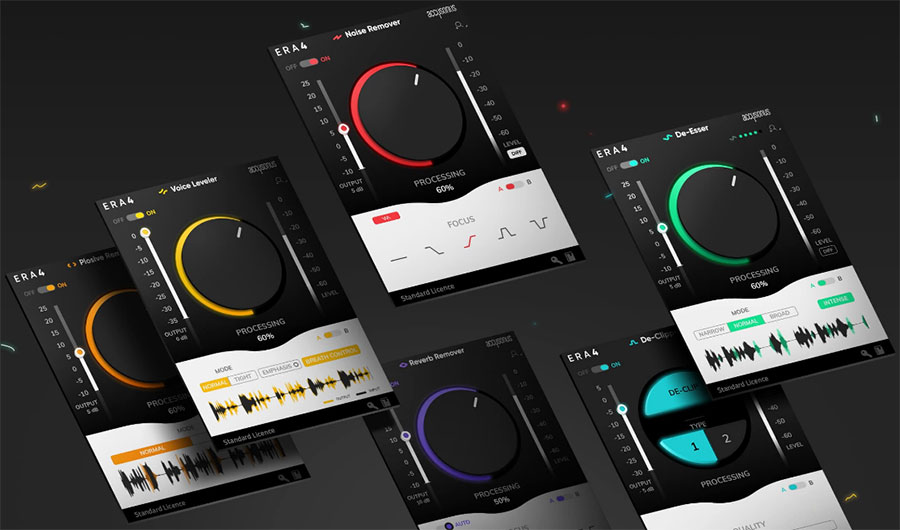
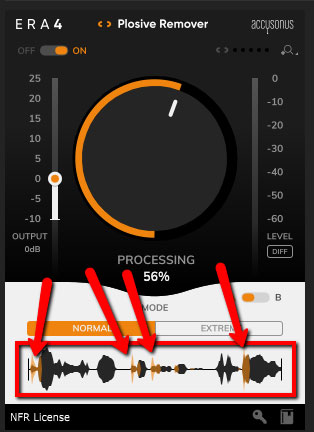
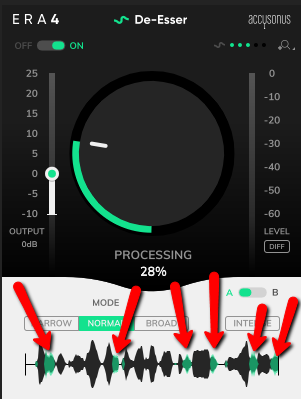
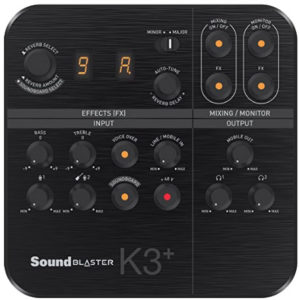 I just did a review of the new
I just did a review of the new 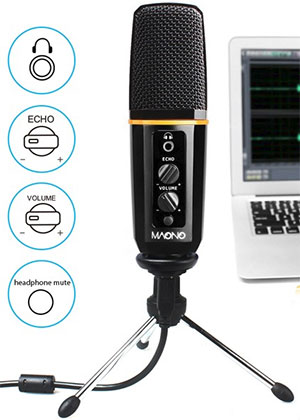 I just tested a USB mic called the Maono AU-901, which a USB microphone. The mic is intended primarily for podcasting, gaming, Skype, video voice-over, etc.
I just tested a USB mic called the Maono AU-901, which a USB microphone. The mic is intended primarily for podcasting, gaming, Skype, video voice-over, etc.